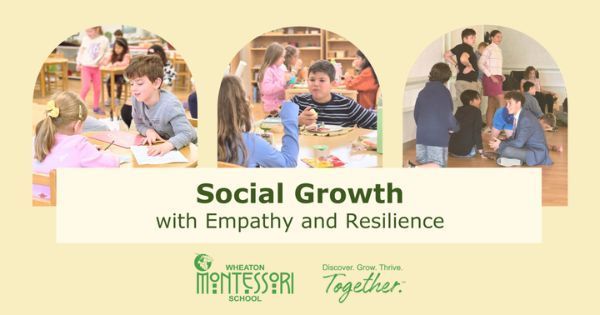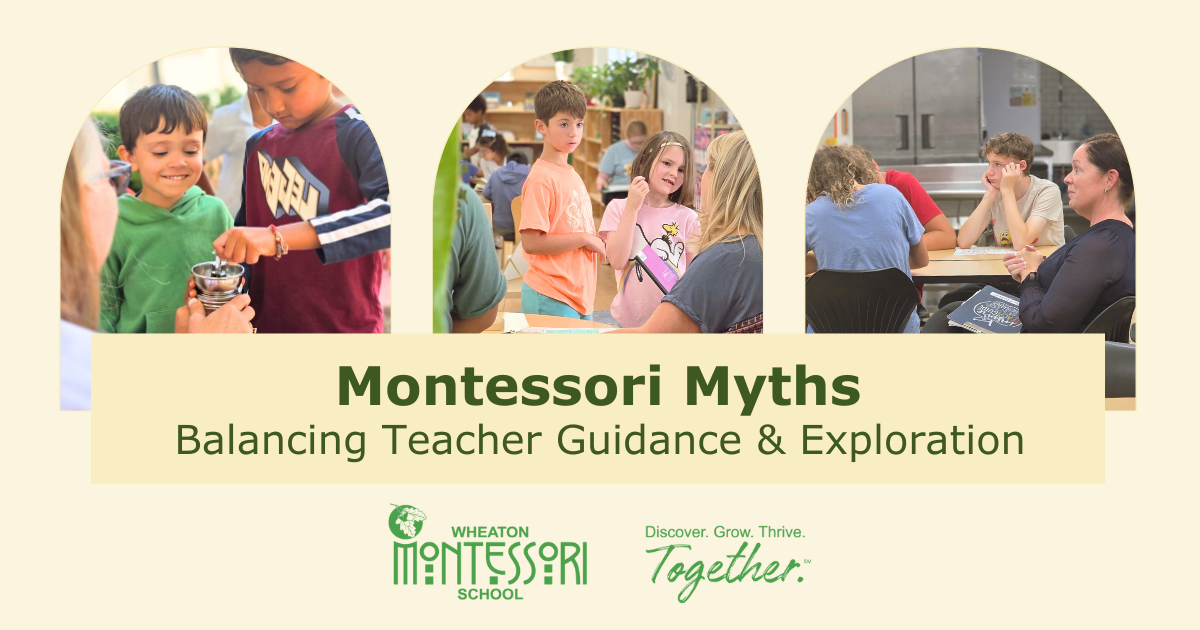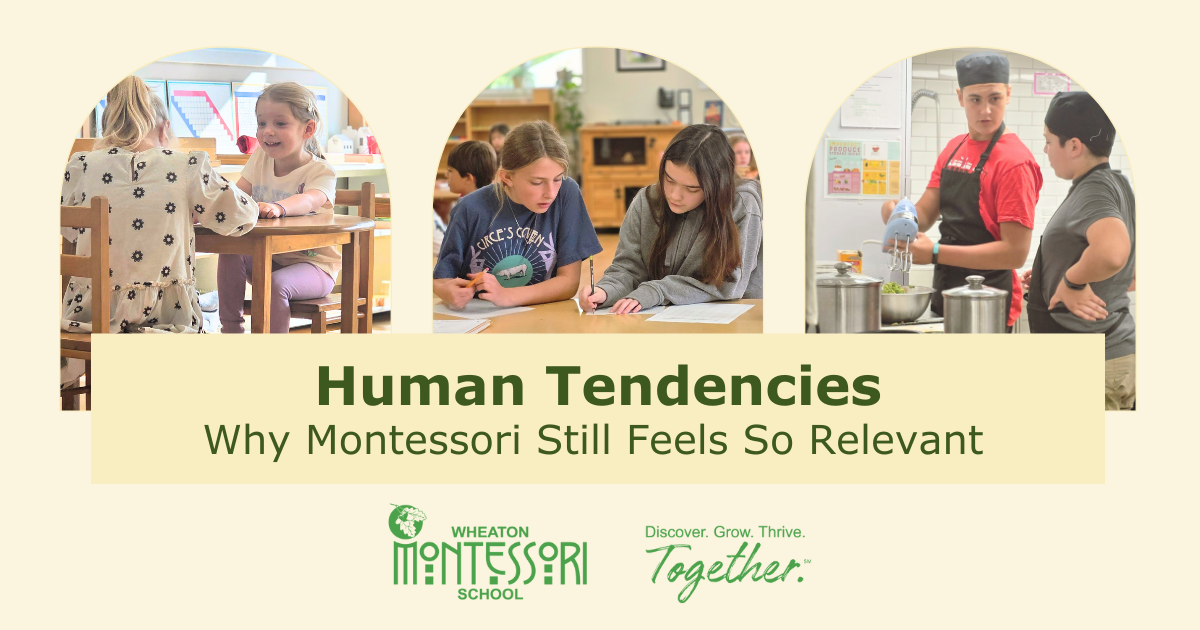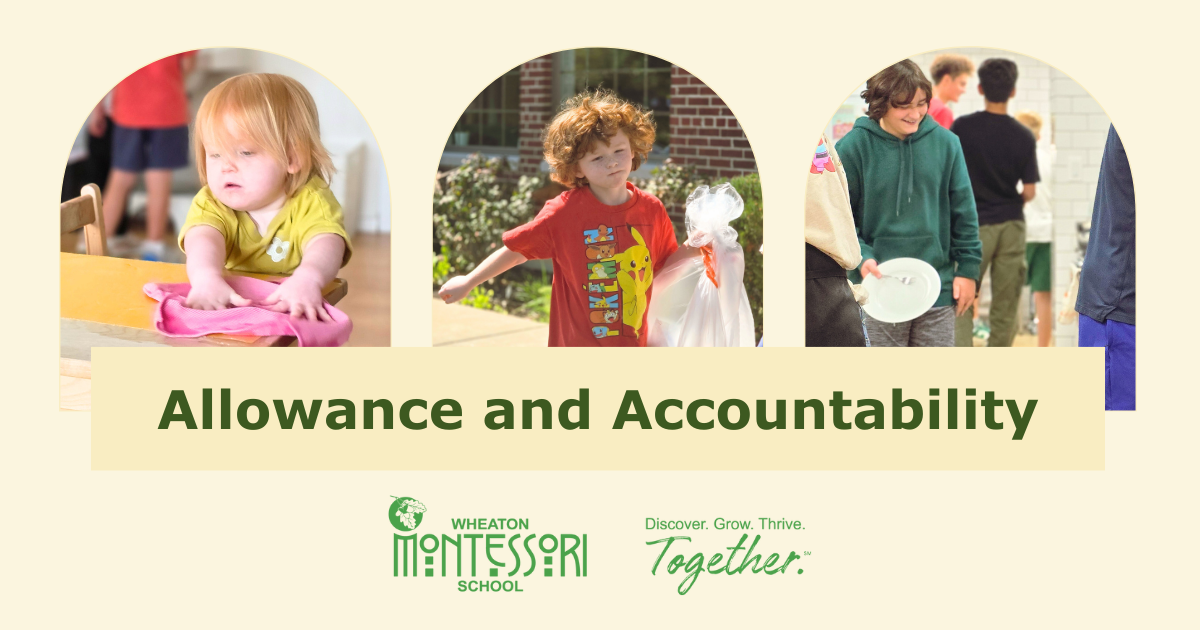Blog

To all the grandparents and grandfriends in our lives, with deepest gratitude: Thank you for being our family’s anchor, for your steady love, your wisdom, and for helping not just our children and adolescents, but us as parents and teachers feel supported. You are more than relatives; you are part of our community’s village. You are living bridges between today’s children and the deeper wisdom of experience. You are the unconditional love we need as grandchildren and are the support that we need as parents. Thank you. We see you holding a steady hand through the messy, emotional, and unpredictable work of raising children and adolescents. When one cries, whines, rebels, or acts out, thank you for not leaping to worst-case conclusions. You have seen the cycles, weathered the storms, and understand how often childhood’s turbulence is normal and simply requires time. Your calm confidence reminds us to trust the process. We are grateful. You embody calm truths. You offer a presence that affirms even when the young ones puzzle us or the adolescents forget “important” things. Having played this game before, you offer a comforting confidence in each child, adolescent, and young adult. You believe in us and our dreams. You know that children grow, heal, learn—and that today’s discomforts often resolve into tomorrow’s strength. Thank you for the meals you cook, the stories you tell, the adventures you lead, the rides you offer, the educational choices you support, the tears you soothe, the self-doubts you ease, and perhaps most of all, the patient witnessing of childhood, adolescence, and young adulthood unfolding. You show us, grandchildren, caregivers, parents, and teachers alike, that we are not alone. Thank you for being keepers of continuity and reminding us that a struggle today is full of promise, young humans becoming who they are meant to be. Because of you, we are reassured that someone believes deeply in who we will each become. You accept us in our imperfections as we grow, and you show us how to live with grace. We are so grateful for all of you, our neighbors, chosen relatives, and family by bond and by love. Thank you, grandparents and grand friends. Your perspective is a gift beyond measure. During our annual Grandparents’ and Grandfriends’ Day on Tuesday, November 25, at Wheaton Montessori School, we honor the grandparents and grandfriends who have touched our lives with their love, wisdom, and stories. This special day celebrates the generations who inspire, guide, and shape our children with their experiences and care.

In a world where parenting and education often default to over-scheduling, micromanaging, and high-stakes achievement, two philosophies stand out for their balance, wisdom, and deep respect for the child: Lighthouse Parenting, coined by Dr. Kenneth Ginsburg, a pediatrician and adolescent medicine specialist. The Montessori Method, developed by Dr. Maria Montessori, an Italian physician and educator. At first glance, one is a parenting model and the other an educational framework. But look more closely, and you'll find they share a profound common ground: both recognize that children thrive not when they're controlled, but when they're guided with care, clarity, and trust. The Shared Philosophy: Respect, Trust, and Autonomy Lighthouse Parenting teaches us to be the calm, steady presence in a child’s life. Like a lighthouse, a parent offers safety and guidance—but doesn’t steer the ship. Children are allowed to make choices, face challenges, and learn from experience, while knowing there’s a safe harbor when needed. Montessori education emphasizes the prepared environment, freedom within limits, and the role of the adult as a guide, not a director. The child is seen as naturally curious and capable, needing space, not pressure, to reach their full potential. Both approaches believe that children learn best when: They feel safe and supported (emotional security). They are given appropriate freedom (autonomy). They are trusted to be capable of growth (respect). How Lighthouse Parenting Mirrors Montessori Principles Let’s explore specific parallels between the two approaches:
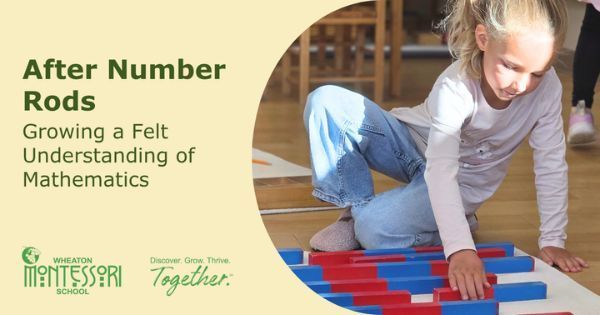
In Montessori classrooms, mathematical understanding begins long before symbols or equations appear. It begins in the body. When young children carry Number Rods—red and blue wooden bars of increasing length—they are not merely learning to count. They are internalizing what quantity feels like. The rods show quantities in a fixed, linear, and measurable form—not loose, individual, or separate units. This difference is subtle but powerful. In many conventional early math settings, children are shown three buttons or four apples and asked, “How many?” Montessori children certainly have those experiences too, through materials like Cards and Counters. But the Number Rods introduce something more abstract: quantity as something continuous and measurable. A rod of six is one solid piece, not six separate ones. It represents a fixed magnitude that can be compared, combined, or measured—laying the foundation for the number line, for operations, and for the idea that numbers express magnitude as well as count. “This concept can be compared to an eight-ounce glass of water: you don’t have eight separate ounces, you have a glass that is eight ounces. It’s a whole quantity, not a sum of parts. Likewise, the Number Rods offer children an experience of number as a unified magnitude. The “six” rod is not three twos or two threes; it is simply six. That understanding, that a number can be both composed and whole, bridges a crucial conceptual gap for later mathematics.” Kelly Jonelis, Adolescent Program Director and Math Teacher Through countless experiences—carrying, comparing, building stair patterns, and making “ten combinations”—children begin to feel relationships between numbers. They see that five is longer than three by exactly two, and that these relationships are consistent and reliable. This concrete sense of equivalence and proportion quietly becomes the basis of estimation, measurement, and algebraic thinking. Even extensions like “memory games” or exploring one meter in length serve a larger purpose. The child’s repeated interactions with fixed quantities help them internalize what Montessori called “materialized abstraction.” They are learning, through movement and perception, what it means for a quantity to exist in space and time—a step far deeper than counting individual items.
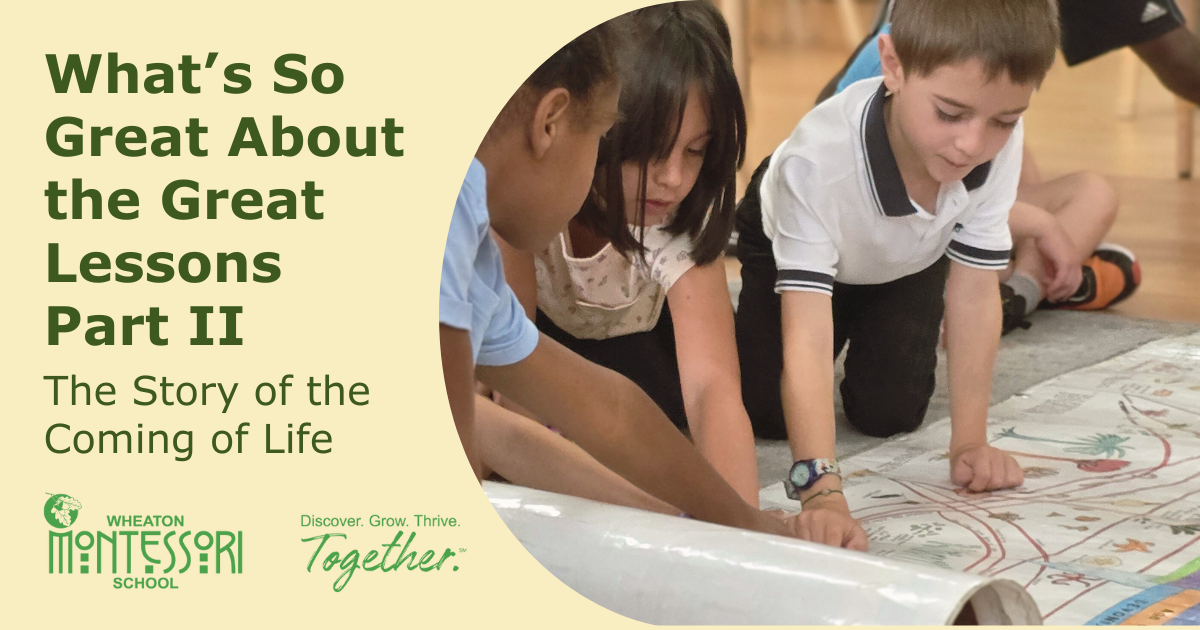
Where it All Began: The Story of the Universe In the first Great Lesson, the Story of the Universe, students were introduced to the concept that as the universe formed, every particle was given a set of laws to follow. As each speck of matter set about following its laws, they gathered together into groups and settled down into one of three states: the solid, the liquid, and the gaseous. The Earth gradually cooled into a somewhat spherical form with a surface marked by lots of ridges and hollows. The ridges are the mountains, and the rains filled in the hollows to make the seas. The Coming of Life: A New Beginning The Story of the Coming of Life picks up here, with the sun looking down at the Earth and noticing some trouble going on. As the rains fell, they mixed with gases from the air, which introduced a lot of salt into the seawater. Additionally, the rocks were being battered by the sea and breaking off, adding more minerals and salts to the water. Dr. Montessori anthropomorphizes the sun, the air, the water, and the mountains very entertainingly as they each blame one another for all the trouble. The Timeline of Life: Evolution Unfolds Then, an answer appears in the form of a little “blob of jelly” which arrives in the sea. This bit of jelly is given a special set of directives that none of the others have: the ability to eat, grow, and make more of itself. Gradually, the blob of jelly divides into multitudes of creatures who set about eating the minerals from the sea and developing into increasingly complex organisms. Some of these animals ate one another, while others used the minerals in the sea and the light from the sun to make their own food. Our Timeline of Life accompanies the story. Dr. Montessori purposely does not try to show every type of animal that has ever existed on this timeline. She selects just a few examples to show the progression of life from the single-celled organisms and trilobites to the first animal with an internal skeleton (the fish) to the first animal to try out life on the land (amphibians – also the first voice!) to the reptiles, who worked out a way to live independently of the water by cultivating scaly dry skins and eggs with shells. The children hear about how the reptiles grew in size and in number to become the masters of the earth, while some enterprising small creatures learned to survive on the fringes, raiding the reptiles’ nests and developing warm body coverings to survive in the colder temperatures that the reptiles couldn’t tolerate. These birds and mammals also learned to care for their eggs and babies. These adaptations helped them to thrive while those giant reptiles…well, we don’t have them around anymore, do we? Wonder, Curiosity, and Ongoing Discovery The childr en are fascinated by this story, which sets up for them the basic laws that govern all living things, providing a framework for the biology work they will undertake in the elementary classrooms at Wheaton Montessori School. It also serves as an epic tale of how the earth was prepared for the coming of one very special animal that was unlike any other…us! From here, the students will pick up on any number of details to investigate further. Already, I’ve had first graders studying the fossils of trilobites and crinoids (sea lilies) and others embarking on dinosaur research. The key concepts that were introduced in this story will be refined throughout their time in the Elementary community by lessons on the parts of the plants and their functions, the classification of plants and animals, and the systems of an animal’s body. And these ideas are further integrated as they apply them in their research projects about plants, animals, fossils, rocks, minerals, and limestone, oceans, rivers, and mountain.
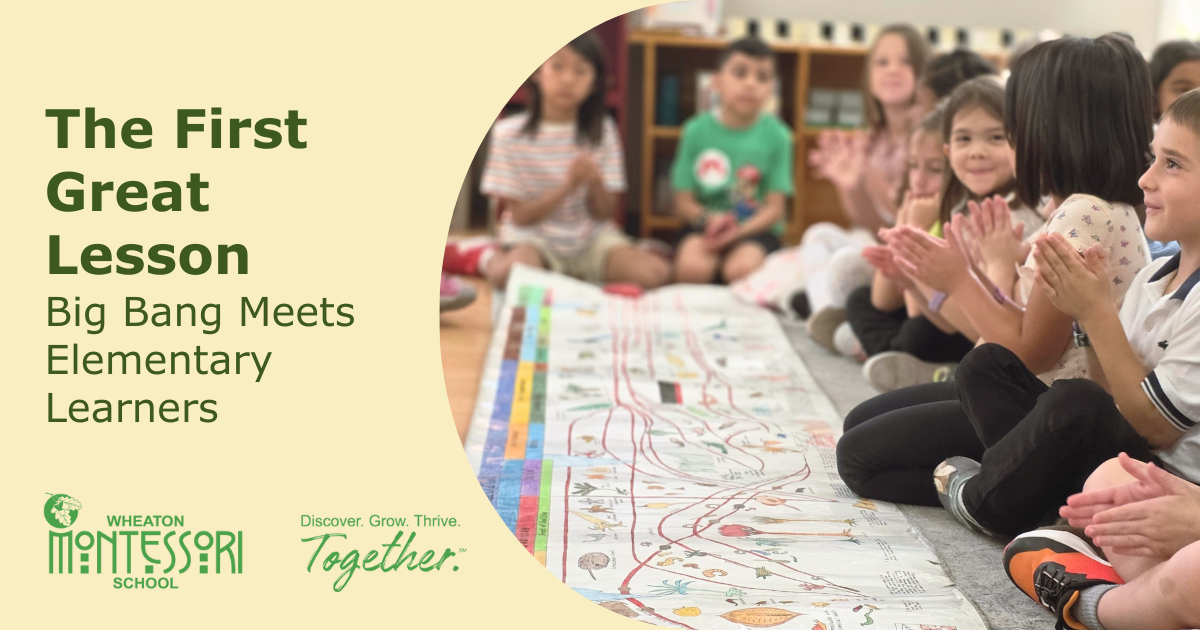
The First Great Lesson: Big Bang Meets Elementary Learners At Wheaton Montessori School, we begin elementary education with a bang. Literally. Known as The First Great Lesson, this powerful introduction to the Montessori elementary curriculum is more than just a lesson. It’s an experience. Often called The Coming of the Universe , it’s a sweeping, story-driven journey through the cosmos. But here’s what makes it unique: it’s not just a science lecture packed with facts and figures. It’s told as a dramatic, awe-inspiring story, beginning with a moment of complete stillness, followed by: “Once upon a time... there was nothing. Then—BOOM—everything.” A Story That Sparks Curiosity The First Great Lesson captures the big picture of how the universe began, moving through the formation of stars, planets, and the laws of nature. But the goal isn't to deliver every scientific detail. It’s our goal to ignite wonder and plant seeds of curiosity that lead students to ask why and how. Why do stars shine? How did volcanoes form? What forces shaped our planet? That spark of curiosity is what drives meaningful learning. Why Tell It as a Story? Dr. Montessori’s use of storytelling is intentional. First through sixth graders are in a stage when their imagination, sense of morality, and desire to understand everything are expanding. The First Great Lesson taps into these characteristics by offering a narrative framework that makes room for wonder. It gives children a reason to care, to question, and to dig deeper. The Gateway to Everything From this one lesson, an entire world of study unfolds. At Wheaton Montessori School, you’ll see students: Exploring states of matter through experiments Creating models of volcanoes and Earth's layers Studying star formation and black holes Building timelines of Earth's history Diving into physics, chemistry, geology, geography, and beyond And it all starts with that initial story. From Inspiration to Investigation of Your Place in the Universe The First Great Lesson doesn’t try to teach everything. It gives an impression, an experience that opens the door to deeper, more focused learning. After listening to this story, learners research, experiment, and explore subjects in greater scientific depth. The First Great Lesson inspires children by conveying: “You are part of a huge, beautiful, ordered universe, and your work is to explore it.” Wheaton Montessori School, your teachers, and your community are here to support you every step of the way! We can’t wait to watch your research, presentations, and experiments develop! Because at Wheaton Montessori School, education isn’t just about information, it’s about inspiration.


